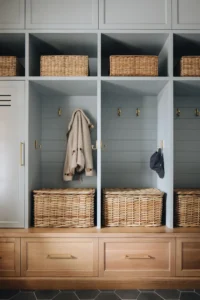These trends could benefit homeowners
Home remodeling and additions continue to evolve, driven by lifestyle changes, technological advancements, and a focus on sustainability. Homeowners seeking to upgrade or expand their homes can benefit from understanding current trends, allowing them to make informed decisions that maximize both function and value. Whether it’s incorporating smart home technology, improving energy efficiency, or rethinking traditional layouts, these trends can guide homeowners toward a more modern and efficient living space.
1. Open-Concept Living Spaces
One of the most popular trends in home remodeling is the shift toward open-concept living spaces. This design philosophy eliminates unnecessary walls and partitions, creating a more seamless flow between rooms. The open-concept layout is particularly appealing for families who want to maximize interaction, whether it’s in the kitchen, living room, or dining area.
This trend is not only about aesthetics but also functionality. Open-concept spaces allow more natural light to penetrate deeper into the home, creating a brighter and more inviting atmosphere. Homeowners can also enjoy greater flexibility when it comes to furniture arrangement, as there are fewer walls dictating the placement of key pieces.
In addition, open-concept living spaces are ideal for entertaining. Whether hosting a dinner party or a family gathering, the absence of walls makes it easier for hosts to engage with guests while preparing food or managing other tasks. This trend caters to a modern, casual lifestyle that prioritizes connection and ease.
An important consideration when implementing this trend is structural integrity. Removing walls requires careful planning to ensure that load-bearing elements are accounted for. Consulting with a contractor or structural engineer is essential to achieve the desired result without compromising safety.
2. Energy-Efficient Upgrades
Energy efficiency is another top priority for homeowners, and it is a trend that continues to gain momentum. From whole-home remodeling to specific additions, incorporating energy-efficient features can result in significant long-term savings. Upgrades such as better insulation, energy-efficient windows, and LED lighting are key elements of this trend.
One of the most impactful energy-efficient upgrades is the installation of high-performance windows. These windows are designed to prevent heat transfer, keeping the home warmer in the winter and cooler in the summer. By reducing reliance on heating and cooling systems, homeowners can lower their utility bills and decrease their carbon footprint.
Insulation is another area where energy efficiency plays a major role. Spray foam insulation, for example, is a popular choice for its superior thermal performance and air-sealing properties. Ensuring that your home is properly insulated is one of the most effective ways to improve energy efficiency, especially in older homes or when completing an addition.
Solar panels are becoming increasingly popular as well. With advancements in solar technology and incentives from governments, more homeowners are investing in renewable energy sources. Solar energy helps offset electricity costs and reduces the home’s overall energy consumption, contributing to a more sustainable lifestyle.
3. Smart Home Integration
Smart home technology has moved from being a luxury feature to becoming a standard part of home remodeling and additions. Homeowners today are interested in integrating smart systems that make their living spaces more convenient, secure, and energy-efficient. From smart thermostats to automated lighting, these innovations can significantly enhance a home’s functionality.
Smart thermostats, like those from Nest or Ecobee, allow homeowners to control their heating and cooling systems remotely. They can also learn daily routines and adjust temperatures accordingly, optimizing energy use and reducing utility bills. Some systems even provide energy usage reports, offering insights into how homeowners can further reduce consumption.
Lighting is another area where smart home integration can shine. Automated lighting systems can be programmed to turn on or off based on occupancy, time of day, or even voice commands. This reduces energy waste and provides convenience, especially for families with busy schedules.
Security is another critical component of smart home technology. Video doorbells, smart locks, and security cameras can be managed from a smartphone, providing homeowners with peace of mind when they’re away. Smart systems that integrate security features with home automation make homes safer while adding an extra layer of convenience.
4. Multifunctional Spaces
Another emerging trend in home remodeling and additions is the creation of multifunctional spaces. As more people work from home or seek flexible living arrangements, homeowners are looking for ways to maximize the utility of every square foot. This trend emphasizes versatility, with spaces designed to serve multiple purposes.
For instance, home offices are no longer solely dedicated workspaces. Many are now designed to function as guest rooms, hobby spaces, or workout areas. Built-in storage solutions, fold-away desks, and modular furniture help transform rooms to fit the needs of the moment. This flexibility is essential in homes with limited square footage, where every room needs to serve more than one purpose.
Kitchens are also seeing a shift toward multifunctionality. Islands are now being designed with additional storage, built-in appliances, or seating areas, allowing the kitchen to function as a cooking, dining, and gathering space. Open shelving and movable cabinetry contribute to this trend by offering flexibility in how the space is used.
Finally, outdoor living spaces are being designed with year-round functionality in mind. Patios and decks are being transformed into extensions of the indoor living area, with features like outdoor kitchens, fire pits, and retractable screens. These additions make it easier for homeowners to enjoy their outdoor spaces regardless of the season.
5. Sustainable Materials and Eco-Friendly Designs
Sustainability has become a critical factor in home remodeling and additions, driven by growing environmental awareness and the desire for healthier living spaces. More homeowners are seeking out eco-friendly materials and designs that minimize environmental impact while improving indoor air quality and energy efficiency.
One of the biggest trends in sustainable remodeling is the use of reclaimed and recycled materials. From reclaimed wood flooring to recycled metal roofing, these materials offer both environmental benefits and unique aesthetic appeal. Not only do they reduce the demand for new resources, but they also give homes a distinctive character that can’t be replicated with mass-produced materials.
Low-VOC (volatile organic compounds) paints and finishes are another popular choice among eco-conscious homeowners. These products emit fewer harmful chemicals, contributing to better indoor air quality and a healthier living environment. This is particularly important in homes where children or individuals with respiratory issues live.
Water efficiency is also a key consideration in sustainable home design. Homeowners are increasingly installing low-flow fixtures, rainwater harvesting systems, and drought-resistant landscaping to reduce water consumption. In regions prone to water shortages, these features are not only practical but also necessary for long-term sustainability.
Home remodeling and additions are evolving to meet the demands of modern homeowners. Trends such as open-concept living, energy efficiency, smart home integration, multifunctional spaces, and sustainability are shaping how people approach home improvement projects. By staying informed about these trends, homeowners can make choices that enhance both the functionality and value of their homes, ensuring they meet current needs while preparing for the future.






